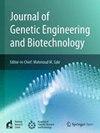Co-expression of HIF1A with multi-drug transporters (P-GP, MRP1, and BCRP) in chemoresistant breast, colorectal, and ovarian cancer cells
IF 2.8
Q3 Biochemistry, Genetics and Molecular Biology
Journal of Genetic Engineering and Biotechnology
Pub Date : 2025-05-01
DOI:10.1016/j.jgeb.2025.100496
引用次数: 0
Abstract
Therapeutic resistance poses a significant challenge in treating most cancers and often leads to poor clinical outcomes and even treatment failure. One of the primary mechanisms that confer multidrug resistance phenotype to cancer cells is the hyperactivity of certain drug efflux transporters. P-GP, MRP1, and BCRP are the key ABC efflux pumps that collectively extrude a broad spectrum of chemotherapeutic drugs. Besides, HIF1A, a master transcription regulatory protein, is also associated with cancer development and therapeutic resistance. Thereby, this study aimed to delve into the mechanisms of drug resistance, specifically focusing on HIF1A-driven overexpression of ABC transporters. A total of 57 chemoresistant and 57 paired control tissue samples (breast, colorectal, and ovarian) from Bangladeshi cancer patients were analyzed to determine the co-expression level of ABC transporters and HIF1A. Molecular docking was also conducted to evaluate the interactions of HIF1A protein and hypoxia response element (HRE) sequences in the promoter regions transporter genes. This study revealed that HIF1A is significantly overexpressed in chemoresistant tissues, suggesting its pivotal role in chemoresistance mechanisms across malignancies and its potential as a target to overcome therapeutic resistance. The findings from this study also suggest a direct upregulation of ABCB1, ABCC1, and ABCG2 transcription by HIF1A in chemoresistant cancer cells by binding to the HRE sequence in the promoter regions. Thus, inhibition of these interactions of HIF1A appears to be a promising approach to reverse chemoresistance. The findings of this study can serve as a foundation for future research, resolving molecular intricacies to improve treatment outcomes in chemoresistant patients.

HIF1A与多药转运体(P-GP、MRP1和BCRP)在化疗耐药乳腺癌、结直肠癌和卵巢癌细胞中的共表达
治疗耐药性对大多数癌症的治疗提出了重大挑战,往往导致临床结果不佳,甚至治疗失败。赋予癌细胞多药耐药表型的主要机制之一是某些药物外排转运体的过度活跃。P-GP, MRP1和BCRP是关键的ABC外排泵,共同挤出广谱化疗药物。此外,HIF1A作为一种主转录调节蛋白,也与癌症的发展和治疗耐药性有关。因此,本研究旨在深入研究耐药机制,特别关注hif1a驱动的ABC转运蛋白过表达。对来自孟加拉国癌症患者的57个化疗耐药组织样本和57个配对对照组织样本(乳腺、结直肠和卵巢)进行分析,以确定ABC转运蛋白和HIF1A的共表达水平。我们还进行了分子对接,以评估HIF1A蛋白与启动子区转运基因中缺氧反应元件(HRE)序列的相互作用。本研究表明,HIF1A在化疗耐药组织中显著过表达,表明其在恶性肿瘤化疗耐药机制中的关键作用,以及其作为克服治疗耐药靶点的潜力。本研究的结果还表明,HIF1A通过结合启动子区域的HRE序列,直接上调化疗耐药癌细胞中ABCB1、ABCC1和ABCG2的转录。因此,抑制HIF1A的这些相互作用似乎是逆转化疗耐药的一种有希望的方法。本研究的发现可以作为未来研究的基础,解决分子复杂性以改善化疗耐药患者的治疗效果。
本文章由计算机程序翻译,如有差异,请以英文原文为准。
求助全文
约1分钟内获得全文
求助全文
来源期刊

Journal of Genetic Engineering and Biotechnology
Biochemistry, Genetics and Molecular Biology-Biotechnology
CiteScore
5.70
自引率
5.70%
发文量
159
审稿时长
16 weeks
期刊介绍:
Journal of genetic engineering and biotechnology is devoted to rapid publication of full-length research papers that leads to significant contribution in advancing knowledge in genetic engineering and biotechnology and provide novel perspectives in this research area. JGEB includes all major themes related to genetic engineering and recombinant DNA. The area of interest of JGEB includes but not restricted to: •Plant genetics •Animal genetics •Bacterial enzymes •Agricultural Biotechnology, •Biochemistry, •Biophysics, •Bioinformatics, •Environmental Biotechnology, •Industrial Biotechnology, •Microbial biotechnology, •Medical Biotechnology, •Bioenergy, Biosafety, •Biosecurity, •Bioethics, •GMOS, •Genomic, •Proteomic JGEB accepts
 求助内容:
求助内容: 应助结果提醒方式:
应助结果提醒方式:


